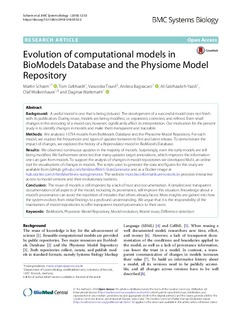| dc.description.abstract | Background
A useful model is one that is being (re)used. The development of a successful model does not finish with its publication. During reuse, models are being modified, i.e. expanded, corrected, and refined. Even small changes in the encoding of a model can, however, significantly affect its interpretation. Our motivation for the present study is to identify changes in models and make them transparent and traceable.
Methods
We analysed 13734 models from BioModels Database and the Physiome Model Repository. For each model, we studied the frequencies and types of updates between its first and latest release. To demonstrate the impact of changes, we explored the history of a Repressilator model in BioModels Database.
Results
We observed continuous updates in the majority of models. Surprisingly, even the early models are still being modified. We furthermore detected that many updates target annotations, which improves the information one can gain from models. To support the analysis of changes in model repositories we developed MoSt, an online tool for visualisations of changes in models. The scripts used to generate the data and figures for this study are available from GitHub github.com/binfalse/BiVeS-StatsGenerator and as a Docker image at hub.docker.com/r/binfalse/bives-statsgenerator. The website most.bio.informatik.uni-rostock.de provides interactive access to model versions and their evolutionary statistics.
Conclusion
The reuse of models is still impeded by a lack of trust and documentation. A detailed and transparent documentation of all aspects of the model, including its provenance, will improve this situation. Knowledge about a model’s provenance can avoid the repetition of mistakes that others already faced. More insights are gained into how the system evolves from initial findings to a profound understanding. We argue that it is the responsibility of the maintainers of model repositories to offer transparent model provenance to their users. | nb_NO |
